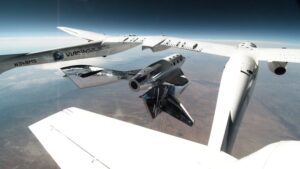SpaceShipTwo makes first flight to space from New Mexico
By Jeff Foust

WASHINGTON — Virgin Galactic’s SpaceShipTwo made its first flight to space in more than two years May 22, completing the first in a series of four suborbital flights planned by the company over the next several months.
The SpaceShipTwo vehicle named VSS Unity, with pilots CJ Sturckow and Dave Mackay on board, took off from Spaceport America in New Mexico at 10:34 a.m. Eastern, carried aloft by its WhiteKnightTwo aircraft. The plane released VSS Unity at 11:26 a.m. Eastern, at which time the spaceplane fired its hybrid rocket motor for approximately 60 seconds.
VSS Unity ascended on a suborbital trajectory before gliding back to a runway landing at Spaceport America at 11:43 a.m. Eastern. The company did not webcast the flight, providing only updates via social media, although NASASpaceFlight.com did webcast the successful release and powered ascent of the vehicle.
The flight was the first human launch to space from New Mexico. Besides the two pilots on board, the vehicle carried payloads for NASA’s Flight Opportunities program.
VSS Unity, our two pilots and @NASA_Technology supported experiments are now in space. #VirginGalactic
— Virgin Galactic (@virgingalactic) May 22, 2021
This was the first SpaceShipTwo flight since one in December that was aborted just as the hybrid motor ignited. The plane glided back to a safe landing, and the company traced the problem to electromagnetic interference from a new flight computer system, an issue the company spent several months correcting. After addressing a potential maintenance issue with WhiteKnightTwo, the company confirmed plans for this test flight May 20.
The flight was the first trip to space for SpaceShipTwo since a February 2019 flight from the Mojave Air and Space Port in California. That flight carried three people to the edge of space, but also suffered damage to a horizontal stabilizer only recently revealed, prompting a safety review and a series of upgrades to the vehicle.
This flight was the first of four SpaceShipTwo missions the company has scheduled for this year. The company plans on the next flight to carry four employees, along with the two pilots flying the vehicle, to test the passenger cabin and flight procedures that future customers will follow.
That would be followed by a third flight with the company’s founder, Richard Branson, on board. That will still be considered a test flight, company executives said last fall when they announced those plans. “Who better to assess the experience of what we’re doing here?” Michael Colglazier, chief executive of Virgin Galactic, said then.
A fourth flight is intended to be a fully commercial flight for the Italian Air Force, carrying payloads and several people. Virgin said in its May 10 earnings call that the flight will generate $2 million in revenue, or $500,000 per seat.
The company hasn’t published a schedule for those upcoming flights, other than expecting them to be completed by the fall. Both VSS Unity and the VMS Eve WhiteKnightTwo vehicle will then go into a “multi-month” maintenance period before beginning regular commercial operations, which Virgin Galactic now anticipates to be no sooner than early 2022.
That schedule is far behind the company’s original schedule from 2004, which anticipated beginning commercial flights before 2010. Virgin Galactic suffered extensive development delays, as well as an October 2014 test flight accident that destroyed the first SpaceShipTwo vehicle, VSS Enterprise, and killed co-pilot Michael Alsbury.
As with the aborted test flight in December, Virgin Galactic did not invite media or many guests to Spaceport America to observe this test. The company said in December that pandemic-related restrictions prevented it from hosting guests at the spaceport. However, nearly all of the state has now moved to “turquoise” in a color-coded framework, the lowest level of risk that allows most businesses to nearly fully reopen.
May 22, 2021 at 09:34PM
via SpaceNews read more...

Post a Comment